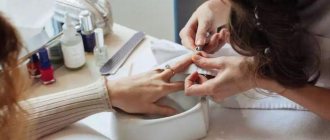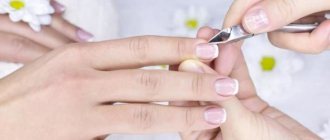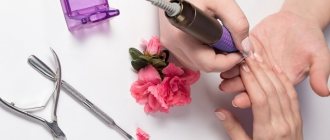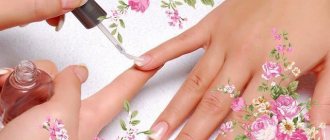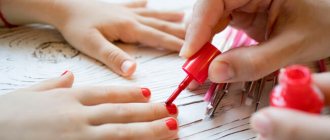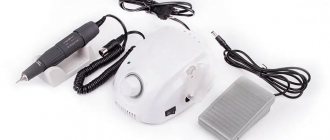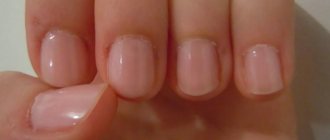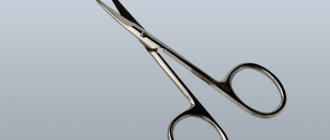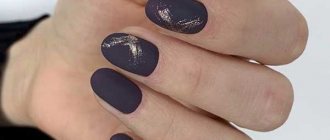The beauty of hands and fingers is important for both men and women. Attending a manicure is an important stage in self-care, since it is the hands that most often reveal how attentive and careful a person treats himself. At the same time, even the most polished look can be completely ruined by unkempt fingers and nails. Manicure techniques are varied; there are both more modern and time-tested techniques. The classic method of nail care includes trimmed manicure, the features of which will be discussed in this article.
What is a trim manicure and what does it include?
The name of the procedure largely speaks for itself. So, in the process of implementing this type of manicure, rough skin and cuticle are removed mechanically using sharp tweezers. The event involves a number of stages, including correction of the shape of the nail plate, a bath, removal of all excess skin growths, nutrition of the nail with useful compounds and coating with clear varnish or colored enamel at the client’s request.
This type of manicure has both its positive and negative sides. The advantages include:
- ease of implementation. The master is required to have a minimum set of standard tools and experience, but once you get the hang of it, you can carry out the procedure yourself;
- fast and obvious results. Today, only this method can tidy up neglected hands in one session, removing all rough areas and overgrown cuticles;
- availability. Unlike other methods, this is implemented in every salon at an affordable cost.
As for the significant disadvantages, here we need to highlight: the need for careful care of the reusable instrument for the safety of the procedure, the risk of damaging tissue, creating the preconditions for the active formation of hangnails, or deforming the nail bed with too much pressure.
What type of pedicure is better?
Which pedicure is better, hardware or edged? Below, we will list the main advantages and disadvantages of each type of foot treatment so that you can compare and choose which one is best for you. So, which is better, trimmed or hardware pedicure?
Trim pedicure
Advantages:
- Quickly completed, takes no more than 15-20 minutes, depending on the speed of the wizard
- It is inexpensive because it does not require the use of additional special equipment
- Available in every salon and from masters of any level and price category, since this is where training begins
Flaws:
- There is a high probability of cuts, even if handled very carefully and slowly
- The appearance of a “thin skin” effect due to the fact that coarsened particles are removed quickly and in a large layer
- The presence of several contraindications for which it is not recommended to do a pedicure
Hardware pedicure
Advantages:
- More delicate treatment, exfoliation of skin in small particles without discomfort
- Elimination of cuts and other damage, the cutter is designed for gentle treatment of the skin and does not injure it
- No discomfort after the procedure caused by removing large areas of rough skin
Flaws:
- Higher cost, hardware treatment will cost 10-20% more than a classic edged manicure
- Not available in all salons, especially in small towns, since not all craftsmen have machines with cutters
- It takes longer, 20-30 minutes, since processing the skin with a cutter is slower than with a machine
So, which is better, hardware or classic pedicure? Based on the advantages and disadvantages of both types of treatment, we note that classic pedicure should be preferred if you want to save time and money, have no contraindications or damage to your feet, and your skin is not particularly sensitive and will withstand intensive treatment without discomfort. Hardware pedicure is better if you have delicate skin, do not want to experience discomfort and are willing to spend more time and money on visiting the salon.
What you need for the procedure at home
To implement the procedure for putting your nails and fingers in order, you will need very few tools that can be easily purchased and stored at home for self-care. So the list looks like this:

- manicure scissors. There are several possible variations here. The first type is standard scissors with fairly wide working surfaces for cutting the free edge of the nail. The second type is cuticle scissors; they are narrower and smaller, which allows for delicate manipulations. And finally, the last option is a universal one, of average thickness and length, which is suitable for any of the tasks listed above;
- pieces. Knipsers (nippers in their common sense) are visually similar to wide tweezers with a sharp edge, and are most likely to be found in any home. They can either remove the length of the free edge or carefully nibble off excess skin on the side ridges and cuticles. But for convenience, it is better to purchase professional nippers - they are very sharp and you will need to get used to them, but as soon as you gain experience, the process of manicure or pedicure will go much faster and better;
- pusher - a spatula that allows you to push back the cuticle and remove from the surface of the nail that thin layer of skin that grows on it;
- a nail file (needed to give a beautiful shape to the free edge) and buffs for grinding and polishing the surface of the nail.
Classic technology involves a preliminary nail bath. It can be done either simply in warm water or with the addition of liquid soap or oils.
Why is it dangerous to use unsanitized tools?
A tool that has not been disinfected can cause infections. The risk is especially great if the tool is used by several people. There are several stages of instrument processing: cleaning, disinfection and sterilization.
- Cleaning is simply rinsing the instrument with water and cleaning agents.
- Disinfection is carried out by placing the instrument in a special solution for a short period of time - such treatment is sufficient at home for an instrument used by one person. As a result, microorganisms located on the surface die.
- Instruments are sterilized using autoclaves, dry heaters, and sterilizers. This treatment eliminates the occurrence of bacterial and fungal diseases on the hands, hepatitis B and HIV when using the instrument on several people.
List of sources
- nailme.ru
- ladysdream.ru
- womenshealth.su
- salon-nagorkogo.ru
- lifegirl.ru
- idealnyi-manikur.ru
- 1lats.com
How to do a manicure correctly: technology
The technology for carrying out the procedure is the same, but in the professional sphere there is one important stage that is excluded when doing a manicure yourself - sterilization of instruments. To avoid infection when working with common trimming tools, they must be treated with a special compound and placed in a sterilizer before each subsequent client. It is better to have individual files for each of the regular visitors, or treat them with a disinfectant composition.
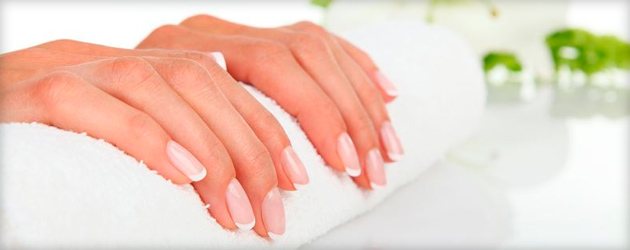
So, the algorithm for performing a trim manicure is as follows:
- the old coating is removed from the nails;
- the free edge of the nail is adjusted to the desired length and shape;
- hands are placed in a bath at a temperature of about 40 degrees for 10 minutes to soften the skin;
- Using a pusher, the softened cuticle is pushed back and carefully trimmed with nippers;
- also, if necessary, excess skin on the side bolsters is removed, and hangnails are carefully cut off;
- then the surface of the nail plate is treated with nutritional compounds, sanded and polished;
- If desired, a coating is applied to the nails, and at the very end, a special oil is applied to the cuticle area, rubbing it in a little with your fingers.
Step-by-step video tutorial for beginners
In the process of implementing a trim manicure, details and care are important, since the slightest mistake or too sudden movement can lead to injury and the resulting potential dangers. To learn all the nuances, we recommend watching this video material. Step-by-step master classes with detailed explanations will be an excellent theoretical basis for implementing high-quality manicure.
Master class on implementation
Preparatory stage
- All instruments are disinfected in a special chamber or using alcohol solutions if the procedure is carried out at home.
- Hands are treated with antiseptic.
- If the nail plates are covered with varnish, it can be removed with a nail remover.
Treatment of nail plates
- Using a nail file, the nails are given the required shape.
- It is recommended to start processing with the little finger and finish with the thumb.
- The file must be professional to avoid delamination and damage to the edge of the plate.
Filing technique
Only clean and dry hands should be processed.
- The file should be manipulated in one direction, starting from the left side, otherwise you can seriously damage the nail plate. The file should file the inside of the nail.
- The nail plate is given the desired shape, however, we do not recommend rounding the side edges too much.
- To eliminate small roughness, you can use a block or buff.
Baths for softening cuticles
- Fingers are immersed in a special container with warm water.
- You can add essential oils, herbs or sea salt to the liquid.
- When the skin softens, you can complete the procedure.
- While your fingers are wet, you can treat your nails with a special brush to remove any remaining filings or cuticle particles.
Cuticle removal
- Excess moisture is removed from the fingers.
- The cuticle is treated with a special preparation for removal - but this is not necessary.
- Using an orange stick, the peel is carefully moved away from the plate and lifted up slightly. It is necessary to act delicately to avoid damage.
- All elements are trimmed with sharp, sterile tweezers.
How often to do
The frequency of trimming manicures is fully determined by the degree of neglect of the hands. So, in order to bring everything into perfect condition, you will need several weekly events. Trimming a manicure takes a lot of time, and there is simply no need to do it often if the nails are in normal condition. Thus, many act according to the following scheme: once a month they attend a comprehensive trimming procedure, and the rest of the time, if the need arises, they carry out supporting measures using simpler techniques, either independently, or also by visiting a beauty salon. This allows you to keep your hands in perfect condition and save your time.
Possible consequences after trimming manicure
The most common complaint about the procedure is that burrs appear after a trimmed manicure. This can happen due to the slightest violation in the process of its implementation. For example, during processing of the side rollers or cuticles, living skin was touched, or the tissues were not softened enough for comfortable trimming. Also, the chance of getting hangnails increases if cutting the cuticle is carried out not in one smooth movement, but in several jerky ones.
During the trimming procedure, there is a high risk of injury as the tools used are very sharp. But the most dangerous consequence should be considered infection when the skin is injured, which becomes the result of improper or absent disinfection after other clients. This can result in severe inflammation, suppuration, and more serious complications.
Peculiarities
The peculiarity of a trim manicure is the removal of the cuticle and rough growths around the nail. No additional equipment or special tools are required for execution. A standard manicure set is enough. When creating, metal tools are used. This type of nail care is suitable for any woman.
In European manicure, the cuticle is not removed; it is softened by steaming in a hot solution with the addition of emollients or remover. Then they are pushed away with wooden spatulas. This nail treatment method is not suitable for everyone. If the cuticle skin is rough and dense, it is better to do a trim manicure.
Hardware or edged manicure - which is better?
Hardware manicure is carried out using a special device that drives cutter attachments. With their help, you can perform any manipulations with your nails to bring them into decent shape. It is worth noting that both the hardware and trimming methods have both pros and cons, so it is impossible to clearly say which one is better. The client himself chooses what is more comfortable for him.
Thus, the hardware procedure is non-traumatic and allows for the highest quality treatment of the nail plate, and the entire process will take less time. But it’s unlikely to be possible to remove the cuticle as well as using nippers, and it’s simply not possible to carry out all the manipulations on wet skin.
Video about types of manicure and its features
